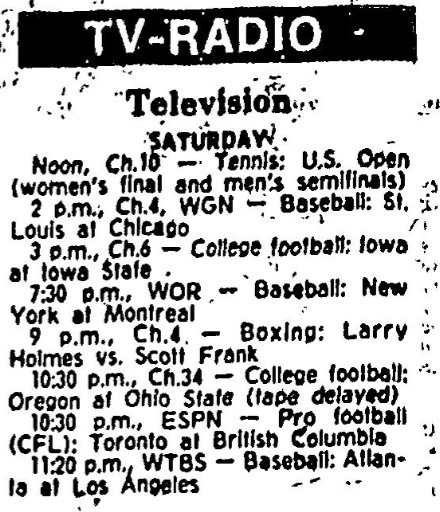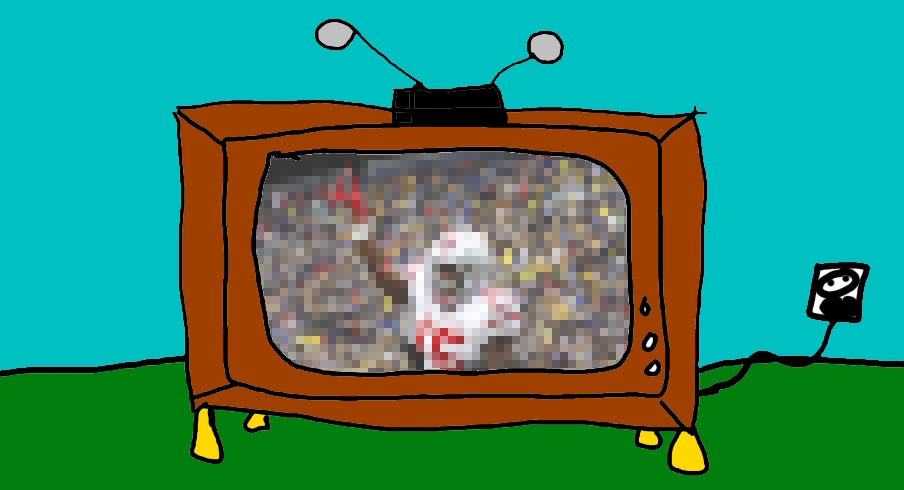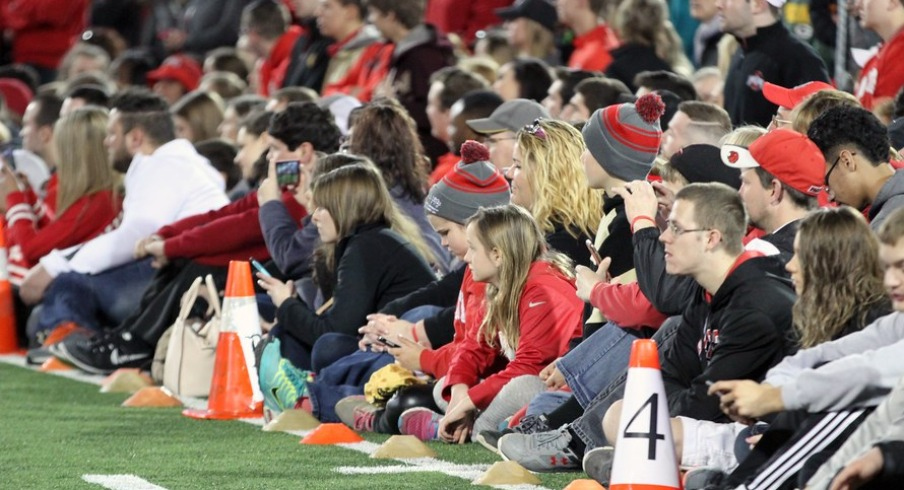Once upon a time, long, long ago, you could turn on your TV on a crisp fall Saturday and know the Buckeyes would be there to watch.
In those halcyon days, known as "about half of the years in the late 90's and early 2000's", if you had a cable subscription, you were golden: ABC and the various iterations of ESPN (and whatever other channel had the out of conference opponent) had you covered with every single Ohio State game, from September through the Bowls.

This hadn't been the norm in Ohio State football broadcasting history, and prior to the 1990's it was common for most games to be shown only after a lengthy tape delay, or sequestered entirely to radio. This was deliberate; the NCAA wanted to limit the number of college football games on television as a way to drive up attendance numbers (as a side note, the NFL kept its version of the blackout rule until the year of our Lord two thousand and fifteen).
If this sounds dumb and counterproductive, it's because it was. Luckily in 1984 the Supreme Court ruled in NCAA v. Board of Regents of the University of Oklahoma that this violated the Sherman and Clayton Anti-Trust Acts, and as a result more college football began appearing on TV screens and money somehow appeared out of nowhere, stuffing great gobs of itself into the pockets of universities and governing bodies of the sport. Obviously a lot of this was regional: If you were an Ohio State fan in Hawai'i, sorry, you're probably going to get the Rainbow Warriors instead of the Buckeyes.
But if you were in Ohio State's media footprint, for a while it was much, much easier to watch them on TV.
This approach worked, and resulted in a cornucopia of college football being broadcasted on basic cable by the late 90's. Because those were my formative television watching years, my assumption of course was that A) that was the best possible way to watch college football (it was), B) this would last forever (it uhhhh did not), because C) broadcasters were content to rake in huge ratings with a reliable audience and a built-in market based on a product that was almost guaranteed to be in most American houses (they were not).
Instead, what happened was a fragmentation of broadcasting rights, which the Big Ten has been at the forefront of twice now. First, with the creation of the Big Ten Network (later just BTN), and second with a new contract that splits the broadcasting rights for the conference about fifty different ways, resulting in this:
Dropping some BIG news pic.twitter.com/cg8MXf3epl
— Peacock (@peacock) May 31, 2023
Yeah, laugh at Michigan having their season opener on a streaming service if you want, but what you're looking at is Ohio State's very near future.
A man glowers at his desk, staring at a pile of papers that have, up until this very late hour, been aggressively ignored by himself and everyone around him. But time now grows very, very short and the papers are urgent (because they're important) and important (because they're so urgent).
Originally it was the kind of pile that cohabitates with pens and sticky notes until you think hey, it's part of the family now, it'd be cruel to get rid of it. So it sits, kicks off its shoes, and gets maybe a little too comfortable amongst the rest of the work you have to do. Too busy to do anything about it, you just decide to wait and hope the pile will eventually go away on its own. It does not, forcing you to at long last do your damn job, however reluctantly and shoddily.
The man picks up the pile of papers, and in his haste, several documents fall and scatter around the table. He could bend down and pick them back up, but he's devoted too much mental energy into this whole enterprise already, and leaves them to their fate. He clutches the remaining papers to his chest, and runs out of his office, door slamming behind him.
The above scenario is, literally, the basis of Marbury v Madison and the entire concept of judicial review (and I mean literally; in the affidavit James Marshall submitted to the Supreme Court, he says he left some of the to-be-delivered letters of commission behind because he couldn't carry them all with his stubby little arms), but when I read about Kevin Warren leaving a bunch of unfinished television and broadcasting contracts for the Big Ten and incoming commissioner Tony Petitti, this scenario popped back into my head.
Seven billion dollars worth of broadcast rights, involving three major networks and an entire ecosystem of streaming services, are in flux right now. As reported by Pete Thamel on ESPN.com:
Nearly three months before the season kicks off and those TV deals begin, the Big Ten does not have completed longform contracts, which include the fine print details. Instead, Petitti is engaged in significant "horse trading," according to multiple sources, to get the NBC primetime deal finished and figure out what the network calls "outstanding issues" in order to uphold as much value as possible.
I'm sure it'll all get hashed out, but the question I keep asking myself is "Is all of this mess really worth it to make college football accessible on streaming platforms?"

After all, that's the end goal here, right? Streaming, the future of mass media! Where once you could pay a flat rate and watch every single Ohio State game, now you get to pay the same amount in piecemeal and probably watch almost every single Ohio State game, as long as there aren't buffering issues or the app doesn't fail or something.
The original promise of streaming was that by cutting out the middleman of the cable companies and making your watching choices purely a la carte, you would save money and get more curated content. You'd pay less because instead of paying Spectrum full price for a package that includes a bunch of home shopping channels you'll never watch, instead you'd just pay a flat ESPN fee and live your dream of the 90's all on one channel, but this time without commercials!
But what if, instead, broadcast rights were spread out? Why, conferences could then charge huge rates to networks, and networks would get a bunch of new subscribers to their niche streaming platforms! And then, what if the media conglomerates that own these networks change their streaming services by adding a bunch of extraneous crap from other channels they own? Heck, they could raise prices as much as they wanted, because people couldn't drop the service without losing the content they signed up for in the first place!
If streaming really does win, that's the future. Not a la carte 24/7 football with no ads, but worse, more expensive cable via a panoply of subscriptions amounting to the same thing. Networks are betting that you'll buy their streaming service, because you've (or at least, people in their 20's through early 40's) become accustomed to being able to easily access college football and think that's the norm.
This is all relative, and I'm sure that traditionally ignored fans of programs Northwestern or Indiana aren't exactly shedding any tears for the beleaguered Ohio State fan with too many choices to watch their team. Still, it strikes me that as late as 2005, a rabbit-eared Magnavox television from 1975 could've shown you nine of Ohio State's twelve games on ABC.
The media landscape around college football has changed as dramatically as it hasn't. We're all streaming AI robot simulations of Ryan Day's facial hair in 8K instead of guessing which CRT pixel is the football.
And twenty years later, everyone gets to make the same choice that they did in the 1980's: buy the service, or don't watch the Buckeyes.


